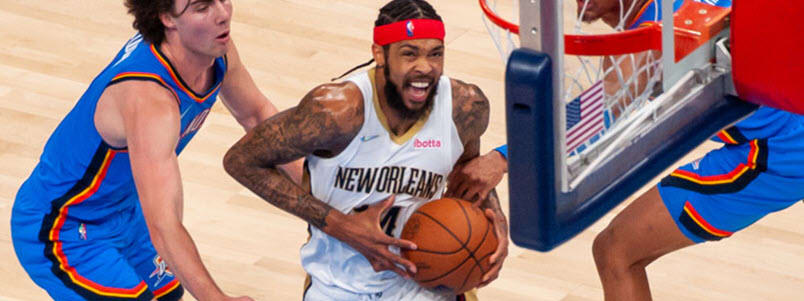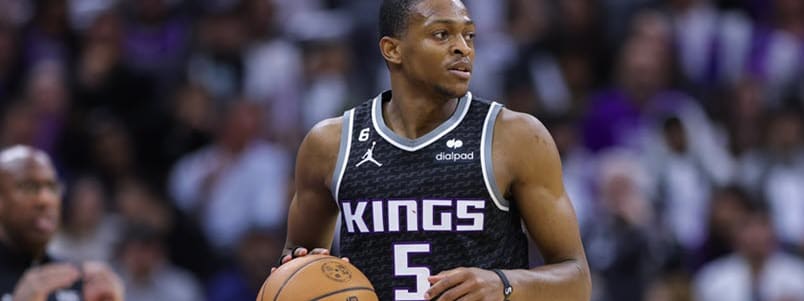Recent RotoWire Articles Featuring Damian Jones
See More
Having played as a backup for his entire career, Jones has yet to establish himself as a player who can impact winning. He split his time across both the Lakers and the Jazz last season, averaging 3.5 points and 3.0 rebounds in 11.6 minutes per night. Although he could very well be listed as the primary backup behind Jarrett Allen, the Cavaliers are likely to shift Evan Mobley into that role at times, rendering Jones nothing more than a deep league option.
Jones put together a run of top-70 production over the final month of the 2021-22 season, earning himself a deal with the Lakers. He will likely begin the campaign as the backup behind Thomas Bryant -- a role unlikely to warrant significant fantasy value. However, if Bryant does not grab his opportunity or gets injured, Jones could be a name to consider based on what we saw over the final few games last season. During the final month, he compiled averages of 14.5 points, 6.1 rebounds, 1.8 assists and 1.3 blocks, shooting an impressive 72 percent from the floor. If he does manage to usurp Bryant, Jones could be worth considering as a backend center, even in moderately competitive leagues.
It was quite a bumpy year for the 26-year-old center, as he bounced around the Pacific Division all year long. Jones started the season on the Suns before being waived after appearing in just 14 games with the team. Next, the Vanderbilt product signed two different 10-day deals with the Lakers and even started in six of his 10 appearances. However, Jones was not brought back on, and he next signed two more different 10-day deals with the Kings. The 6-foot-11 big averaged 6.9 points, 4.5 rebounds and 1.4 assists in 20.0 minutes per game over 20 contests with the team. Jones also added a block per game with the Kings. This season, Jones is back with the Kings but faces steep competition at the position. Richaun Holmes will be the starter while the team added the likes of Tristan Thompson, Alex Len and Neemias Queta in the offseason. The team's strength at the position and Jones' inconsistent play make him a hard fantasy option to trust.
Jones continued seeing backup-center playing time last season, averaging 16.1 minutes of run with the Hawks and averaging 5.6 points on 68.0 percent shooting and 3.7 rebounds. During the offseason, he joined his third team in three years, inking a two-year, $3.7 million deal with the Suns. In Phoenix, Jones will compete for the backup center spot with rookie Jalen Smith. Given that Deandre Ayton will likely see 30-plus minutes per night, there won't be much room for Jones to have fantasy relevance. Only fantasy managers in extremely deep leagues should entertain selecting Jones.
Jones was traded to Atlanta for Omari Spellman after spending the first three years of his career with Golden State. He averaged career highs across the board with 5.4 points, 3.1 rebounds, 1.5 combined blocks/steals and 1.2 assists across 17.1 minutes in 24 games. Jones had surgery on a left pec muscle that cost him much of the season, but he figures to be fully healthy heading into his first year with the Hawks. Jones' per-36 averages were respectable with 11.4 points, 6.6 rebounds and 3.3 combined blocks/steals, showing his ability as a two-way player. He'll be a backup center to Alex Len and compete for minutes with the rookie out of Maryland, Bruno Fernando. Jones will likely see a solid dose of minutes with the second unit, but his usage won't be enough to warrant fantasy consideration in most formats.
The Warriors’ status as perhaps the league’s deepest team has allowed general manager Bob Myers to prioritize talent and untapped potential in the draft the last few years rather than NBA-ready contributors with lower ceilings, and Jones’ selection with the final pick of the first round in 2016 was emblematic of that. The center from Vanderbilt had already suffered a torn right pectoral muscle prior to the draft that ended up sidelining him from contact drills until late November, but Jones’ combination of size (seven feet, 245 pounds) and high-level athleticism was too tantalizing for the Warriors to pass up. Since the 22-year-old was always viewed as a long-term project, he unsurprisingly appeared in just 10 games with the NBA team as a rookie, averaging just 8.5 minutes per appearance. The organization was hopeful that Jones would at least be able to show signs of becoming a dominant post force and capable interior defender while receiving more extended action with the D-League’s Santa Cruz Warriors, and though he struggled to meet those goals initially, he rewarded Golden State’s faith by season’s end. He earned D-League Player of the Month honors for games played in March and April after averaging 17.6 points and 7.8 rebounds across 12 contests, while also doing well to avoid the foul trouble that plagued him previously. Entering his second professional season, Jones still looks to be on the outside looking in for a regular rotation spot with Zaza Pachulia and JaVale McGee above him on the depth chart at center and Draymond Green around to serve as a small-ball option at the position, so expect Jones to move frequently between the G-League and the NBA team in order to pick up minutes. If Jones is able to make further strides in his development this season, he could have an easier path to minutes with the Warriors in 2018-19, as both Pachulia and McGee are set to become free agents next summer.
The Warriors selected Jones with the final pick of the first round in the June draft, marking the second straight season they've chosen a project big man in the first round after grabbing power forward Kevon Looney a year earlier. Like Looney, Jones won't be asked to challenge a rotation spot as a rookie and carries injury risk. He required surgery in June to repair a torn pectoral muscle, which caused him to sit out summer league and figures to sideline him throughout preseason play. The missed development time during training camp will likely prevent Jones from logging more than a handful of appearances in the first half of the season, but that shouldn't dim the luster on the Warriors' investment. The center position is the Warriors' weakest on the roster, and with Zaza Pachulia and Anderson Varejao both on the downside of their careers and on short-term deals with the club, Jones could have a path to fantasy relevance as soon as 2017-18 if his performance in practices, D-League games and his limited opportunities with the Warriors warrant it. While his college numbers from last season at Vanderbilt didn't really pop, Jones' physical attributes are matched by few center prospects. At seven feet and 244 pounds with an outstanding 7-foot-3.75 wingspan, Jones has impressive size and length, and packs plenty of athleticism into his frame. He's unlikely to be the kind of player capable of creating his own shot, but with Stephen Curry and plenty of other talents surrounding him, Jones won't ever be tasked with shouldering a major offensive load.













